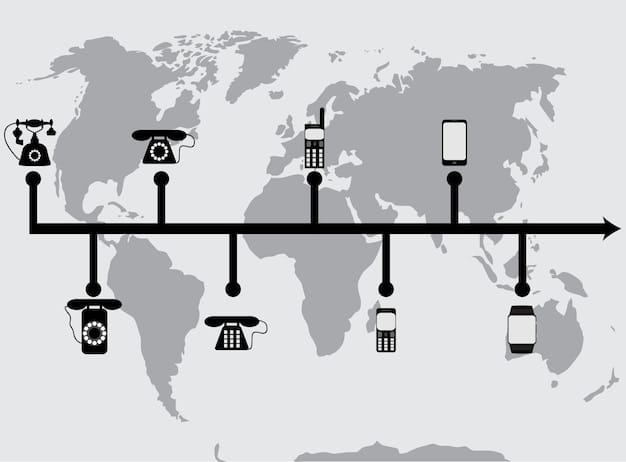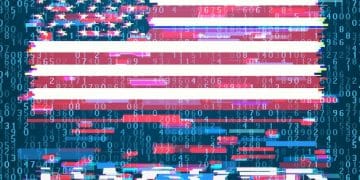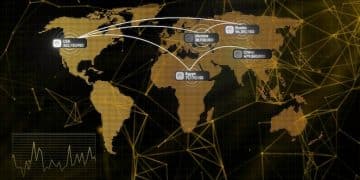Navigating US Export Controls: A 2025 Guide for International Relations

Navigating the complexities of US export controls in 2025 requires a comprehensive understanding of evolving regulations, geopolitical factors, and technological advancements to ensure compliance and mitigate risks in international trade.
Understanding and complying with US export controls is crucial for businesses engaged in international trade. This guide will help you navigate the complexities of US export controls in 2025, providing insights into the latest regulations and best practices.
Understanding US Export Controls in 2025
US export controls are a set of laws and regulations that govern the export of certain goods, software, and technology from the United States. These controls are designed to protect national security, prevent the proliferation of weapons of mass destruction, and advance US foreign policy interests. Navigating these controls requires a clear understanding of the responsible agencies, key regulations, and potential impacts on international relations.
Key Agencies Involved
Several US government agencies play a role in administering and enforcing export controls. Understanding their responsibilities is fundamental for compliance.
- Bureau of Industry and Security (BIS): The BIS, under the Department of Commerce, is the primary agency responsible for implementing and enforcing export controls on dual-use items (items with both commercial and military applications).
- Directorate of Defense Trade Controls (DDTC): The DDTC, within the Department of State, controls the export and temporary import of defense articles and services under the Arms Export Control Act (AECA) and the International Traffic in Arms Regulations (ITAR).
- Office of Foreign Assets Control (OFAC): OFAC, part of the Department of the Treasury, administers and enforces economic and trade sanctions based on US foreign policy and national security goals.
Key Regulations to Know
Familiarizing yourself with key regulations is essential for businesses involved in exporting from the US.
- Export Administration Regulations (EAR): The EAR, administered by the BIS, governs the export, re-export, and transfer (in-country) of dual-use items.
- International Traffic in Arms Regulations (ITAR): ITAR, managed by the DDTC, controls the export of defense-related items and services.
- Sanctions Programs: OFAC administers various sanctions programs targeting specific countries, individuals, and entities.
In conclusion, understanding the roles of key agencies and the specifics of regulations like EAR, ITAR, and OFAC sanctions is paramount for conforming with US export controls. This knowledge ensures that businesses can operate legally and ethically in the international arena, while contributing to global security and stability.
Emerging Trends in Export Controls
The landscape of US export controls is continuously evolving due to technological advancements and geopolitical shifts. Keeping abreast of these emerging trends is critical for maintaining compliance and mitigating potential risks. In 2025, several trends are expected to shape the future of export controls.

Focus on Critical and Emerging Technologies (CETs)
The US government is increasingly focusing on controlling the export of critical and emerging technologies (CETs). These technologies are deemed essential for maintaining US technological superiority and national security. CETs include areas such as artificial intelligence, quantum computing, biotechnology, and advanced manufacturing. Regulations around CETs are becoming more stringent, requiring businesses to conduct thorough due diligence and seek expert advice.
Increased Scrutiny of Foreign Investments
The Committee on Foreign Investment in the United States (CFIUS) is intensifying its scrutiny of foreign investments in US companies, particularly those involved in CETs and other sensitive sectors. This scrutiny is intended to prevent the transfer of sensitive technologies and data to foreign adversaries. Businesses should be prepared for more rigorous reviews and potential mitigation requirements.
Enhanced Enforcement and Penalties
The US government is enhancing its enforcement efforts and increasing penalties for export control violations. This includes stricter monitoring of export activities, more frequent audits, and harsher penalties for non-compliance. Companies need to prioritize compliance and invest in robust export control programs to avoid costly penalties and reputational damage.
These trends collectively emphasize the growing complexity and vigilance surrounding US export controls. By focusing on CETs, increasing scrutiny of foreign investments, and enhancing enforcement, businesses need to prioritize compliance and invest in export control programs. This proactive approach is vital for long-term success and sustainability in global markets.
Preparing for Changes in 2025
Anticipating and preparing for regulatory changes is crucial for ensuring ongoing compliance with US export controls. In 2025, several key areas will likely see significant changes, making proactive preparation essential.
Staying Informed About Regulatory Updates
Staying informed about regulatory updates is essential for any compliance program. Here are some strategies:
- Subscribe to Government Alerts: Sign up for email alerts from the BIS, DDTC, and OFAC to receive timely updates on regulatory changes.
- Monitor Industry Publications: Stay informed about export control developments by reading industry publications and attending relevant conferences and webinars.
- Engage Legal Counsel: Work with experienced legal counsel who specialize in export controls to stay abreast of complex regulatory changes and interpretations.
Conducting Regular Compliance Audits
Regular compliance audits can help identify and address potential weaknesses in your export control program. Key steps include:
- Review Policies and Procedures: Conduct a thorough review of your export control policies and procedures to ensure they align with current regulations.
- Assess Transactional Compliance: Evaluate recent export transactions to identify any compliance gaps or areas for improvement.
- Train Employees: Provide ongoing training to employees on export control requirements and best practices.
Implementing Technology Solutions
Leveraging technology solutions can streamline export control compliance and reduce the risk of errors. Consider implementing:
- Export Control Software: Implement export control software to automate screening, licensing, and record-keeping processes.
- Data Analytics: Use data analytics to identify patterns or anomalies that could indicate potential export control violations.
- AI-Powered Tools: Explore AI-powered tools to enhance compliance efforts, such as automated classification and risk assessment.
Preparing for these changes requires a multifaceted approach, which includes staying informed, conducting compliance audits, and implementing technology solutions. By taking these steps, companies can navigate the dynamic landscape of US export controls in 2025 with confidence and resilience.

Best Practices for Export Compliance
Implementing robust best practices is essential for ensuring ongoing compliance with US export controls. These practices encompass various aspects of export activities, from due diligence to record-keeping. Companies that adopt comprehensive best practices are better positioned to mitigate risks and maintain a strong compliance posture.
Conducting Thorough Due Diligence
Due diligence is the cornerstone of export compliance. Key steps include:
- Know Your Customer (KYC): Verify the identity and background of your customers to ensure they are not prohibited parties or involved in illicit activities.
- End-Use Verification: Determine the intended end-use of your products to assess whether it aligns with export control regulations.
- Red Flag Screening: Screen transactions for red flags that could indicate potential export control violations, such as unusual payment terms or suspicious destinations.
Developing an Export Management and Compliance Program (EMCP)
An Export Management and Compliance Program (EMCP) provides a framework for managing export control risks. Develop an EMCP that includes:
- Written Policies and Procedures: Document clear policies and procedures for export control compliance.
- Designated Compliance Officer: Appoint a designated compliance officer responsible for overseeing the EMCP.
- Training and Education: Provide regular training and education to employees on export control requirements.
Maintaining Accurate Records
Accurate record-keeping is essential for demonstrating compliance and facilitating audits. Ensure you:
- Retain Export Documents: Retain all export-related documents for the required retention period (typically five years).
- Document Compliance Efforts: Document all due diligence efforts, compliance reviews, and training activities.
- Implement a Record Management System: Implement a system for organizing and storing export-related documents securely and systematically.
By diligently implementing these best practices, companies enhance their defense against non-compliance, promote ethical business operations, and contribute to the broader goals of national security and international trade.
Leveraging Technology for Compliance
Technology plays a pivotal role in streamlining and enhancing export control compliance. Leveraging the right technology solutions can help businesses automate processes, reduce errors, and improve overall efficiency. Several innovative technologies are transforming the landscape of export compliance.
Automation Tools for Screening and Licensing
Automation tools can streamline screening and licensing processes, reducing the risk of errors and freeing up valuable resources. Key tools include:
- Automated Screening Software: Use automated screening software to quickly and accurately screen customers, products, and transactions against restricted party lists.
- License Determination Tools: Implement tools that automate the license determination process, helping you identify the appropriate licenses and authorizations for your exports.
- Electronic Export Management Systems (EEMS): Adopt an EEMS to manage export-related data, documents, and workflows electronically.
AI and Machine Learning Applications
AI and machine learning are revolutionizing export compliance by providing advanced capabilities for risk assessment and anomaly detection. Consider these applications:
- AI-Powered Risk Assessment: Use AI-powered tools to assess the risk of export transactions based on various factors, such as destination, end-use, and customer profile.
- Anomaly Detection: Implement machine learning algorithms to detect anomalies in export data that could indicate potential violations.
- Predictive Analytics: Leverage predictive analytics to forecast potential export control risks and proactively address them.
Cloud-Based Compliance Solutions
- Accessibility: Cloud solutions offer accessibility from anywhere, ensuring consistent compliance across different locations.
- Scalability: Cloud platforms can scale to handle growing export volumes and regulatory complexities.
- Updates: Cloud-based solutions automatically update with the latest regulatory changes, reducing the burden on compliance teams.
Technology has revolutionized export compliance. By using automation tools, AI, machine learning, and cloud-based solutions, businesses can streamline processes, reduce risks, and improve efficiency. These innovations are key to effective management of export controls in 2025 and beyond.
Navigating Geopolitical Factors
Geopolitical factors significantly impact US export controls, influencing regulatory decisions and enforcement priorities. Understanding these factors is essential for businesses engaged in international trade. In 2025, several geopolitical dynamics are expected to shape the landscape of export controls.
Impact of International Relations
International relations play a crucial role in shaping export control policies. Key considerations include:
- Trade Agreements: Monitor trade agreements and treaties between the US and other countries, as these can affect export control requirements.
- Diplomatic Tensions: Be aware of diplomatic tensions and conflicts that could lead to new export restrictions or sanctions.
- Alliances and Partnerships: Understand US alliances and partnerships, as these can influence which countries are subject to stricter or more lenient export controls.
Adapting to Changing Global Dynamics
The global landscape is constantly changing, requiring businesses to adapt their export control strategies. Key strategies include:
- Diversification: Diversify your customer base and export markets to reduce reliance on any single region or country.
- Scenario Planning: Develop scenario plans to prepare for different geopolitical outcomes and their potential impact on your export activities.
- Risk Mitigation: Implement risk mitigation measures to address potential disruptions to your supply chain and export operations.
Staying Informed About Sanctions and Embargoes
Sanctions and embargoes are powerful tools used by the US government to advance foreign policy objectives. To stay informed:
- Monitor OFAC Updates: Regularly monitor updates from OFAC regarding new sanctions and embargoes.
- Conduct Sanctions Screening: Screen all transactions against sanctions lists to ensure compliance.
- Seek Expert Guidance: Seek guidance from legal counsel or export control consultants to navigate complex sanctions requirements.
By proactively monitoring international events and building adaptive policies, companies are better positioned to navigate the geopolitical factors influencing US export controls. This approach ensures they can stay compliant and effectively contribute to global security and trade.
| Key Aspect | Brief Description |
|---|---|
| 🛡️ Compliance | Adhering to EAR, ITAR, and OFAC regulations to avoid penalties. |
| 🌐 Geopolitics | Understanding international relations and their impact on export controls. |
| 🤖 Technology | Leveraging AI, automation, and cloud solutions for efficient export management. |
| 🔍 Due Diligence | Conducting thorough checks on customers and end-uses to prevent violations. |
Frequently Asked Questions (FAQ)
▼
The primary agencies are the Bureau of Industry and Security (BIS), the Directorate of Defense Trade Controls (DDTC), and the Office of Foreign Assets Control (OFAC). Each agency has distinct responsibilities in managing export regulations.
▼
CETs are technologies deemed essential for maintaining US technological superiority and national security. They include fields like AI, quantum computing, biotechnology, and advanced manufacturing.
▼
Due diligence helps ensure that exports are not going to prohibited parties or being used for illicit purposes. It involves verifying customer identities and determining the end-use of products.
▼
Technology solutions like automated screening software, AI-powered risk assessment tools, and cloud-based compliance platforms can streamline processes and improve overall efficiency in export management.
▼
An EMCP is a framework for managing export control risks. It includes written policies, a designated compliance officer, and regular training programs to ensure that employees adhere to export control requirements.
Conclusion
Navigating the complexities of US export controls in 2025 requires a proactive and informed approach. Staying abreast of regulatory changes, understanding geopolitical influences, implementing robust compliance programs, and leveraging technology are crucial for success. By prioritizing compliance and adopting best practices, businesses can mitigate risks and thrive in the global marketplace.





